
It’s been almost two years since my last chana masala recipe and that seems like a dangerous length of time. I still have a large stock of Rancho Gordo’s desi chana—which I don’t think they are carrying anymore or planning to bring back. When I cook them, I tend to cycle between the three recipes for those chickpeas that I’ve previously posted (here, here, and here). Of late, however, I’ve hit upon a variation that I like quite a bit more than those. Part of it is that the preparation involves a not unusual method of cooking the chickpeas with a bit of baking soda. This helps them soften up very nicely (and much quicker than without even in my old-school pressure cooker). The masala meanwhile is made very tangy with a fair bit of tamarind and cumin (along with other spices). It’s very tasty indeed and I recommend it highly. If you don’t have a large stock of desi chana and don’t have easy access to an Indian store, you can just use regular Rancho Gordo garbanzos (but you may not need to use the baking soda in that case). Whichever variety of chickpeas you do use, I think you’ll like it. Continue reading
Tag Archives: Vegetarian
Tiranga Dal

It’s been a while since I’ve posted a recipe for dal (this Un-Makhni Dal, cooked with a smoked pork hock). Typically, my dal preps are with single dals. Today’s recipe, however, is for a mix of three dals of three different colours. Hence the name: tiranga or tri-colour. Mixed dal preps are quite common in North India—and I myself have previously posted a recipe that uses four different dals. This is similar, except it leaves out the toor dal and the tadka is not identical. Which is to say, it’s different. This is for me very much a cold weather, comfort food dal. (This is only a personal thing.) It’s a hearty dal with good texture to it and I like to use a lot of julienned ginger in the tadka. You should feel free to tone that down if you like. It goes very well with rice or chapatis and I’ve also enjoyed it very much directly out of a bowl. See how you like it. Continue reading
Tangy Squash with Malvani Masala

The end of the growing season is basically squash season at our CSA, the excellent Open Hands farm. And so October and November usually find me cooking squash in all kinds of ways—from soups to pork combos to grated preparations. One of my favourite squashes is Ambercup; both because it is very tasty and because it does not need to be peeled (I am a very lazy cook). Open Hands usually has a lot of Ambercup in their shares but this year was an exception. While waiting for it to come in I took a flyer on a variety I had never seen or cooked with before: Starry Night. This is a variant of Acorn squash and does not give off much moisture when cooked, making it particularly suitable for dry preparations. It’s a bit fussy to peel, on account of the ridges, but the dish I improvised with it came out rather well: a tangy and slightly spicy preparation that deploys one of my new favourite commercial spice mixes, Bedekar’s Malvani masala. This masala has been available at my favourite desi store in the Twin Cities metro throughout the year but if you don’t see it—or another brand of Malvani masala—in a store near you, you can find it online. Continue reading
Baingan Masala with Mustard

The first recipe of the month featured eggplant; here now is another. I improvised this in mid-October and I think it was the last dish I made with the last of the eggplant from my garden. Truth be told, as much as we like eggplant, it’s been a bit of a relief to not be cooking it twice a week as I pretty much had been since early August! These were all long eggplant: a mix of Ping Tung (a purple varietal) and Thai Long Green. Could this recipe be adapted for globe eggplant? Probably, but cut-up globe eggplant is not going to hold its shape the way that long eggplant cut into thick disks does. Long eggplant is easily found in Indian and other Asian stores though, so that shouldn’t be a difficult hurdle to clear. The key flavour in this dish comes from a spice I threw into my grinder on a whim: black mustard seed. Its sharp bite comes through quite cleanly in the finished dish. If you are able to use mustard oil like a good Bengali then you’ll taste the sharpness even more. But it will be good even with a regular neutral oil. I also use the home-made Bengali spice blend, bhaja moshla, to add a little more punch at the end. This is not commercially available but you can use a pinch of your favourite garam masala instead (if you do, keep the pan on the heat for another minute after adding it). Continue reading
Hot and Sour Baingan Masala

This recipe was on the poll for September and October and it’s time has now come. I improvized it in early August when the flood of eggplant from my community garden plot was in full flow and variety in preparation was needed to keep exhaustion at bay. It turned out so well that I made it a few more times before the growing season ended in October. My eggplant of choice for this was a variety I grew for the first time this year: Little Finger. These plants produce a profusion of very dark purple eggplants that are 3-6 inches in length and tubular in shape. As they’re not commercially available—unless there’s a specialty grower at a farmers’ market near you—you can happily substitute whatever long eggplant you do have access to. Alas, globe eggplant, either cut into rings or cubed, is not optimal for this dish as you want the eggplant pieces to hold their shape and not begin to melt into the sauce. You begin by stir-frying the sliced eggplants, setting them aside, making the wet masala and adding the fried eggplant back in for the last step. While the first step requires constant stir-frying for 10 minutes or so, it is, on the whole, a simple and quick recipe—and I think you’ll find it’s very delicious. Great with pulao or with chapatis or parathas; and excellent as both a side dish or the star of the show. Continue reading
Zucchini “Chenchki”

A vegetable that you enjoy when it first becomes available from the garden in the summer—or in our case, our CSA—but which then increasingly begins to feel like a curse, is zucchini. I don’t grow it for that reason: it’s good but then there’s altogether too much of it. If another gardener offers you some of their zucchini it’s probably a passive-aggressive move—especially here in the upper midwest. But it is a mainstay of the CSA table earlier in the season before the more charismatic vegetables show up and so we find ourselves with a decent amount of it on hand most weeks from mid-July on. As I grill a lot in the summer, it’s easy enough to slice some zucchini, toss it with olive oil, salt and pepper and slap it on the grate. The missus makes a Korean banchan with it as well. And from time to time I put it into Bengali vegetable recipes as well. Continue reading
Baingan with Malvani Masala

Here to close out September in cooking is my third eggplant recipe of the month. (The first was for Baingan-Zeera Masala and the second for Baingan “Bharta”.) Today I have for you a recipe for a simple preparation with Bedekar’s Malvani Masala. If you follow my recipe posts this may strike a chord in your memory. Back in July—when the eggplant from my garden had just begun to come in—I’d posted another recipe that used Bedekar’s Malvani Masala. Malvani cuisine is one of the cuisines of the southwestern coast of India. It’s not very well represented in the US (or the UK, I’d imagine). Indeed, it’s not even until relatively recently that packets of Malvani masala began to appear in desi groceries in the Twin Cities metro and they’re still not consistently or widely available here. Bedekar’s is the brand I’ve seen and bought but any brand of Malvani masala should be close. And if you can’t find it in a desi store near you, you can find it online. I can tell you it’s become one my go-to all-purpose masalas for quick cooking. I’ve added it to various eggplant dishes, to chicken curries and also to beef curries. It’s an easy route to big flavour. Continue reading
Baingan “Bharta”

Almost exactly a month ago I was reeling under the onslaught of eggplant from my plot at the community garden and trying to come up with new ways/variations to cook it all. On this particular occasion I started out to make a variation on baingan bharta but things went off track fast. First, I was feeling too lazy to roast the eggplant. So I figured I’d make a version of the recipe I posted last week, for baingan-zeera masala. As I started to make the masala though I kept adding things willy nilly, almost a bit deliriously. These kinds of experiments can often end badly but wouldn’t you know it, this came out rather well: rich texture and big, bold flavour. The only problem was what to call it. Since I’d started out to make baingan bharta, and since the texture of the finished dish was not a million miles from that of bharta, I figured I’d call it that. But as it’s so far away from the canonical versions of the dish I normally think of as baingan bharta, I’ve put bharta in quotes here. If even that seems wrong to you, you can call it what you like. But do make it. I am pretty sure that if you like baingan/eggplant you will agree that it’s very good. Continue reading
Baingan-Zeera Masala

I started growing eggplant in earnest last summer. And I had such a monstrous bounty that even after giving at least half of it away we almost had more than we could cope with at home. Thankfully, eggplant is a very versatile vegetable and can be cooked in all kinds of ways and so we never tired of it. Though my readers may have, as all my recipes last September involved eggplant. And as I planted a lot of eggplant again in my community garden plot this year I find myself in a similar situation, both in our kitchen and on this blog. Four of the recipes on the poll for this month involved eggplant and it’s by a hair that we missed having another all-eggplant September: only three out of four recipes this month will feature eggplant—what a relief! Where to begin? Well, maybe with the one I made first back in August. It featured not just single garden eggplant but single plant eggplant: all of it came from one Chinese String plant in my garden. Chinese String, as the name might indicate, is a varietal that produces long thin fruit. I’d never grown or encountered it before but certainly hope I’ll be able to find it again next year as we really enjoyed it, in this preparation and others. You don’t need that specific varietal, of course—any long eggplant will do. Continue reading
Purple Potatoes, Red Masala

I’ve previously posted at least three recipes for alur-dom/dum alu (here, here and here). You might think that’s enough but here’s a fourth. Alur dom/dum alu is made in certain broad ways in the parts of India that make dishes by that name. I do like more traditional ways of making it but I also think of the name of the dish as authorizing all kinds of approaches: as long as you cook potatoes, covered, in a thick or thin gravy with masala I think you’ve made alur dom/dum alu. You may disagree but that’s how I see it. Anyway, I don’t know why I’m leading this post off with these observations because this recipe is nothing very wild or unexpected. The only really unusual thing here is the use of small purple potatoes. Everything else is just a matter of plus/minus from ways in which you might already make alur dom/dum alu. You could, of course, make this dish with small yellow or red potatoes as well but I really like the sweet flavour of purple potatoes and think they work particularly well here. Give it a go and see what you think. Continue reading
Mushroom and Cauliflower Curry

I love king oyster mushrooms and buy them every opportunity I get—which is to say, every time I am at a Vietnamese or other East Asian store in the Twin Cities. We cook them up in a number of different ways at home. What I have for you today is a relatively unusual prep for me for these mushrooms but otherwise fairly familiar. By which I mean that this is essentially a take on alu-gobi with the mushrooms taking the place of the potato. A little more gravy than I typically make in alu-gobi and so I’m calling it a curry. There are not very many ingredients and it comes together very easily. I start out by frying the cauliflower and mushrooms till they’re half-done. If you’re short on time you could skip this step. It won’t be quite as good but it will still be very tasty. As with a lot of my recipes, the ingredients list is really a general guideline and not a specific prescription. I used the quantities of cauliflower and mushrooms I had. You could change that ratio and still end up with a very similar dish as long as you stay close to the spice blend. Continue reading
Baingan Masala
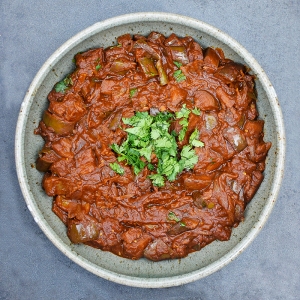
Eggplant season has begun to get underway here in Minnesota—I just harvested my first eggplant today, a small Pot Black. If all goes well, we will have plenty of eggplant in August. And as I am growing three different long varieties (Ping Tung, Nagasaki and Chinese String), I am constantly on the lookout for recipes where these will particularly shine. I am happy to say that this recipe—which I improvised at the end of May—is one of them. The secret weapon here is a commercial masala mix. As I may have mentioned before, one of the things I am exploring more this year is the use of commercial regional spice mixes. There are so many of these available now at my local Indian stores and it’s a world I need to spend more time in. One of the mixes I bought back in May was Bedekar’s Malvani Masala. If you can’t find it near you, you can probably find it online. Malvani cuisine is one of the cuisines of southwestern India, the flavours of which I just love. I used this Malvani masala in a beef curry when I first got it and while that came out quite well it is in this dish that I like it even more. I add it at the point at which I would normally add whatever spice mix I would have ground myself. Coconut milk adds some richness and the final result is a dish with a sticky texture and robust flavour. Give it a go. Continue reading
Bhindi Masala with Yogurt
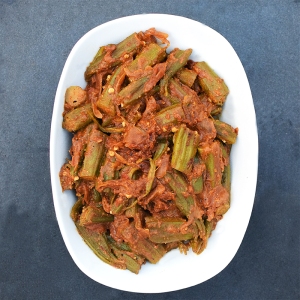
Normally, when I make bhindi/okra, I end up without much conscious thought with this excellent bhindi-fry with onions which is a beloved staple in our house. On some occasions, however, I blaspheme and experiment with other preparations. Not all these experiments are successful enough to merit repetition. This one, however, has joined the semi-regular repertoire. Where the bhindi-fry with onions is minimalist, with barely any spices used, this has a bit more going on—which is not to say that it is particularly complicated. And what it adds in ingredients it subtracts in prep time for the bhindi. You don’t have to slice it thinly. Instead, just cut off the tops and then cut each pod in half (or into three pieces for particularly long pods). The onions provide the base, the spices the punch and the tomato and yogurt add tang and turn the masala into a sticky coating for the bhindi. And if you cook it in mustard oil it will add a bit more pungency around the edges. It goes very well with rice and dal but is even better with chapatis or parathas. Continue reading
Rajma, Take 5
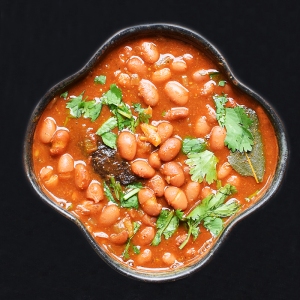
Yes, this is my fifth recipe for rajma—what’s your point? I am forever tinkering with my rajma masala. And when I recently saw dried pomegranate seeds on the shelf at my local desi store (here in the wilds of southern Minnesota “local” means “20 miles away”) I grabbed some just for this purpose. A good rajma masala needs some sourness and pomegranate seeds are a good way to get it. If your local desi store doesn’t carry them, or if you don’t have a local desi store, you can find them on Amazon [affiliate link] or doubtless at many other online outlets. Or I suppose you could sub amchur/dried mango powder. It’s also true that you could save yourself a lot of hassle and just use a good commercial rajma masala—there is no shame in that. Of course, if you’re going to do that you don’t need to read further as the main thing that distinguishes my rajma recipes from each other is the masala I use for them (well, there are other differences too but this is the one that really counts). Continue reading
Mooli Parathas
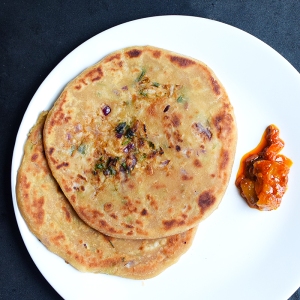
As I said a couple of weeks ago, I spent a fair bit of time in the kitchen on my trip to Delhi in March. I learned some new things and also improved my skills with some others. These masoor dal pakodas fall in the former category and mooli parathas fall in the latter. I will be the first to admit that I am not the most adept maker of chapatis and parathas in the world. I don’t have the best skills with a rolling pin. But what I lack in natural ability I almost make up for in perseverance and so at this point I turn out pretty good chapatis and parathas—plain ones as well as anda/egg parathas and alu/potato parathas. I’ve always been wary of mooli/radish parathas though, even though they are a close second to alu parathas in my personal stuffed paratha rankings. (It’s hip to say that alu parathas are boring compared to mooli or gobi/cauliflower parathas but I didn’t get where I am today—nowhere—by being hip.) This because mooli parathas are a lot more fiddly. For one thing, unlike potatoes, the mooli/radish is shredded not mashed which makes for a more uneven filling. For another, the shredded mooli gives off a lot of water and moist paratha stuffing is not easy to deal with. This can make rolling the stuffed dough a challenge for those of us who are not naturals with a rolling pin. I did get some hands-on lessons from my parents’ cook on this trip though and I am glad to report that the results have been very good. Being a generous guy I will share my success with you. Continue reading
Roasted Cauliflower Soup with Bhaja Moshla
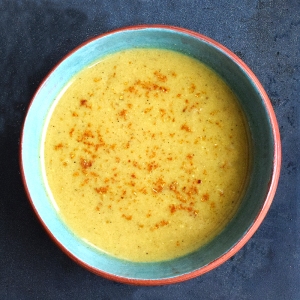
We are of late trying both to reduce the amount of meat we eat during the week and to cut down dramatically on our intake of triglyceride-heavy carbs. Yes, growing old really is a lot of fun. As a result our meals both involve a lot of vegetables and require us to make things that don’t call for rice or chapatis/parathas/tortillas to eat them with. I’ve been making a lot of stews with beans (with and without small amounts of meat) and I’ve also been searing fish and serving it alongside Indian veg dishes in a non-Indian manner (think a piece of fish on a plate with some vegetables alongside). And I’ve been making this cauliflower soup. It uses many of the same spices I’d deploy in a traditional sabzi with gobi. It makes for a very nice meal by itself or with a slice of whole wheat toast. As with my recipe for khatta alu, I garnish it with a pinch of home-made bhaja moshla. If you don’t have any you can sub your favourite garam masala instead. Or you could leave the last bit of masala out completely and just call it roasted cauliflower soup. The main thing is that it is easy and tasty (and perfect in the Minnesota winter). Continue reading
Rajma, Take 4

Yes, it’s true that all my rajma recipes are basically variations on each other. You’re welcome.
This is my fourth recipe for rajma, the Punjabi kidney bean dish that has become increasingly iconic in recent years in American foodie circles interested in Indian food (you can find the others here, here and here). This is a good thing. Rajma is a force for good, especially in cold climates. And it is a rather versatile dish, being very compatible with rice, with chapatis, with parathas etc. and also very amenable to being eaten by itself out of a bowl. I make it all the time here in Minnesota, varying—as is my annoying wont—the ratios of spices and other ingredients each time. And whenever I hit upon a version that I particularly like I share it with you. But do you thank me? No. Well, maybe you thank me, but do you send me money? No, you don’t, you shameless, ungrateful swine. Continue reading
Sweet Potato Curry with Tamarind and Peanuts

Almost all of my cooking is not only improvisatory in nature but also often a hodgepodge of ingredients and approaches from different parts of India. I do sometimes cook from cookbooks that features dishes/cuisines of regions of India other than my own and when I do I follow those recipes closely—at least the first time. But invariably aspects of those recipes—be they combinations of ingredients or broad flavour profiles—enter unpredictably into the improvised dishes I make far more often. Not every bit of hybridization works or has particularly striking results but when one does it feels very satisfying. This improvised sweet potato curry, which draws on ingredients and flavours in dishes from Marathi and various South Indian cuisines, is one of my recent hits. For all I know it ends up close to some community or the other’s traditional preparation of sweet potato. If so, please don’t give me a hard time for departing in some crucial way from a canonical preparation you’re familiar with; this is not trying to be whatever that might be. What I can tell you is that—sour and hot and sweet and thickened with ground peanuts—it makes for a hearty winter meal with rice. Give it a go and see what you think. Continue reading
